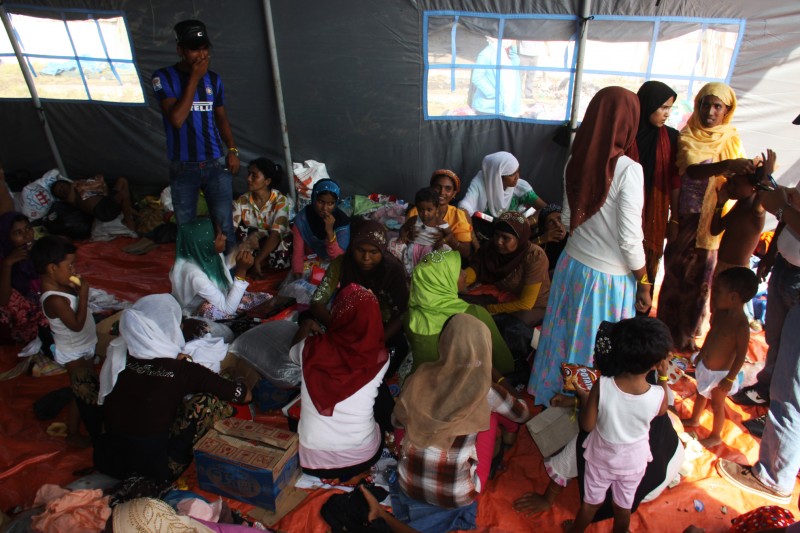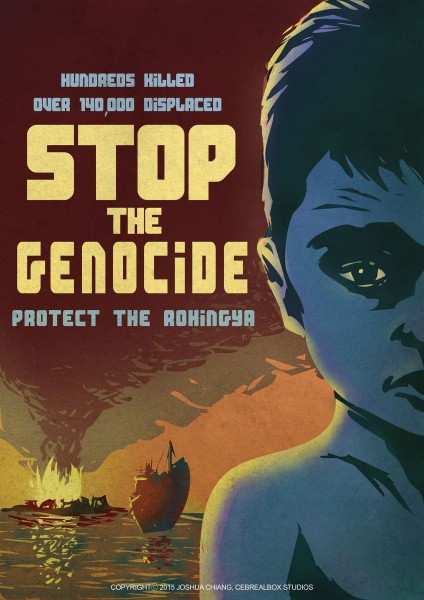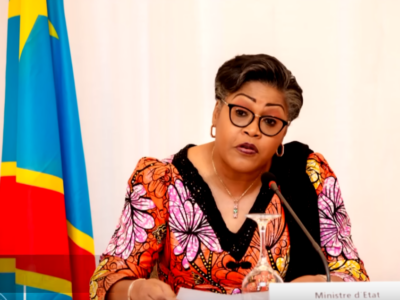
Immigrants from Myanmar and Bangladesh arrive in Langsa, East Aceh in Indonesia. At least 678 immigrants arrived on boats in poor health. Photo by Dodi Kurniawan, Copyright @Demotix (5/16/2015)
Singapore has remained aloof during Southeast Asia's Rohingya refugee crisis even as leaders of neighboring countries have been meeting to find solutions.
The Rohingya belong to a Muslim minority group in Myanmar but the government there has refused to recognize them as citizens. Since they are considered illegal immigrants, they are placed in several refugee camps while many have escaped to nearby countries to seek shelter and work. In the past month, Rohingya boat refugees were rejected by several Southeast Asian governments, decisions which triggered international uproar.
With thousands of Rohingya migrants stranded at sea, countries in Southeast Asia have belatedly been stirred into action. Malaysia, Indonesia and Thailand gathered to discuss their response to the crisis with Malaysia and Indonesia agreeing to provide temporary shelter.
Malaysian Prime Minister Najib Razak has also ordered search and rescue operations to locate migrant boats:
I have further ordered @tldm_rasmi and APMM to conduct search and rescue efforts on Rohingya boats. We have to prevent loss of life.
— Mohd Najib Tun Razak (@NajibRazak) May 21, 2015
Singapore, on the other hand, has declared its inability to take in any refugees. “As a small country with limited land, Singapore is not in a position to accept any persons seeking political asylum or refugee status, regardless of their ethnicity or place of origin,” a Ministry of Home Affairs spokesperson told the press.
This has long been Singapore's policy with regard to asylum seekers. A news report in 1978 covered then Prime Minister Lee Kuan Yew's refusal to accept Vietnamese refugees in which he reportedly said: “You've got to grow calluses on your heart or you just bleed to death.”
In 2012, 40 Rohingya refugees rescued at sea were refused entry into Singapore.
Glendon Giam in Singapore points out the lengths to which Singapore had previously gone to block refugees from entering its territory:
Timely reminder: in 1975, Singapore had “Operation Thunderstorm” to prevent South Vietnamese refugees landing, with lethal force authorised.
— Glendon Giam (@blueproto) May 14, 2015
However, Karen Gwee tweeted that some Vietnamese refugees of 1978 had actually been accepted:
Absolutely no reason for Singapore not to take in refugees – we did it in 1978 http://t.co/2X8jea8Mgq
— Karen (@karen_gwee) May 17, 2015
Those refugees were given shelter in a relatively well-maintained refugee camp, but only if they could be resettled in another country within 90 days.
Other photos from this era are being shared on Facebook by former Vietnamese refugee Lam-Khanh Nguyen.
The latest crisis has led to some Singaporeans calling for the rich island nation to offer shelter – even if temporary – to the desperate refugees.
On Facebook, Miak Siew questions the spending priorities of Singapore:
Folks – you ask me if we host refugees where is the money going to come from.
i ask you – Where does the millions of dollars spent on fireworks for National Day every year come from?you are happy to burn millions shooting lights into the sky, but you are not happy saving lives? Says a lot about our priorities

Singaporean artist Joshua Chiang of Cerealbox Studios designed this poster in support of the Rohingya refugees. Republished with permission
Meanwhile, some Singaporeans are supporting the government's hands off approach, fearing that resettling refugees will be a drain on resources.
Wei Wen explains on Facebook why he understands the position taken by the government:
The much bigger point is where does this all lead to? How will they eventually be resettled? Can they really assimilate and integrate into the society? Are we going to house them for decades and beyond? How long before our generosity is worn thin and we realize that there is no other option but continue? Look at the realities in all these options seriously and tell me that our government should not have the heart to protect the best interests of its people?
While political blogger Alex Au proposes that countries should deploy their navies towards Myanmar to intercept people smugglers and and other victims of human trafficking:
Patrolling about 300 – 400 km of coast is a lot easier than scouring half the Andaman Sea looking for smugglers’ boats. Picking people up before they get hungry or thirsty reduces the amount of costly medical intervention required.
The navies should intercept and check all boats leaving Burmese waters. Refugees or trafficked persons found on board should be removed and the boat seized. Traffickers and boat operators should of course be taken into detention.







4 comments
The mass killings in Paris today by Muslim militants showed that the Singapore government was right not to have a lax policy regarding refugees.
Only self-righteous leftist apologists would think otherwise.
P.S Notice these leftist care more about the plight of other people than the locals back in their home country. And the locals are not stupid NOT to notice it